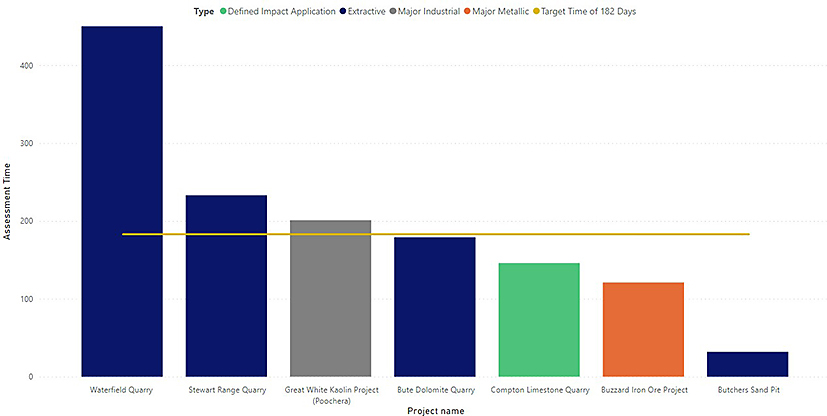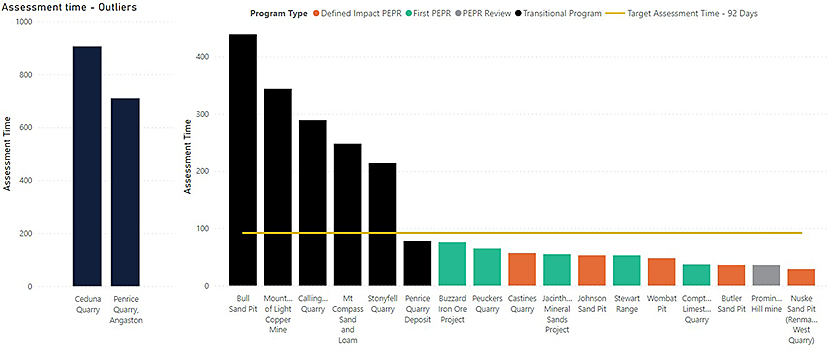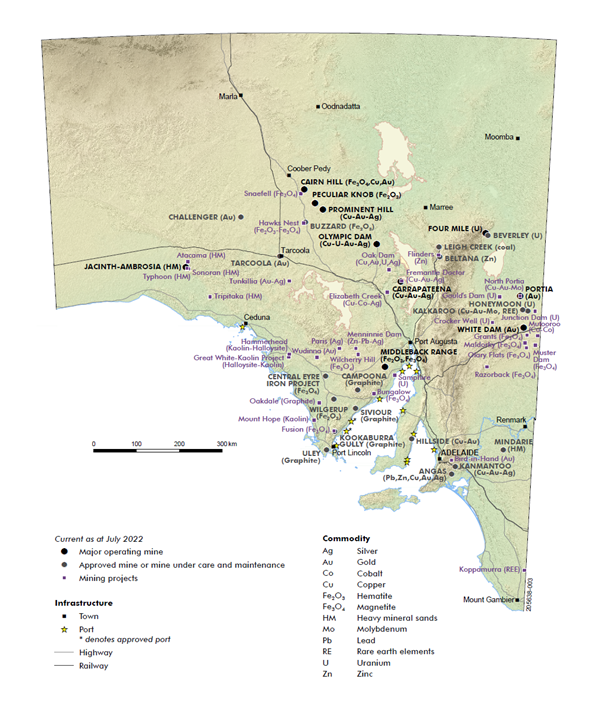Under the Mining Act, the DEM takes the lead role in coordinating the state government assessment processes for all new and ongoing mining operations, using a risk and outcomes-based approach.
DEM’s core assessment functions include the assessment of mining lease proposals which, if approved, provide a right to mine, and subsequent operational programs, which allows on ground works to commence. Operational programs are defined as a program for environment protection and rehabilitation (PEPR) for mining leases or a mine operation plan (MOP) for private mines.
The Mining Act also requires industry to undertake stakeholder engagement when preparing applications for mining tenements and operational programs.
A summary of all programs approved in the last 12 months is available on the DEM website:
Figure 8: Major operating mines, approved mines, mining projects and mines under care and maintenance as at 1 July 2022
Mining assessment times
DEM has targets for mining assessment times that align with the national ‘Mining approvals scorecard’ for reporting assessment timeframes.
Figure 9: Approved mineral lease applications (MLAs) by type of application and timeframe FY2021–22

Note: The Waterfield Quarry assessment time of 450 days was due to multiple requests for further information, and an administrative oversight that resulted in a notice of the application having to be published at a late stage in the Government Gazette.
Figure 10: Program assessments (PEPRs and MOPs) by type of PEPR and target timeframe FY2021–22

Note: Transitional programs refer to update of an old program to a contemporary program. Transition from an older program requires an environment impact assessment to develop outcomes and measurement criteria for a contemporary PEPR or MOP. As the data shows, these types of assessment typically take longer due to the complexity associated with assessing potential impacts on an already developed mine or quarry, a process which is completed during the mining lease application stage for modern mining approvals.
Ceduna Quarry and Penrice Quarry Angaston were excluded from the chart as outliers. The extended Penrice Quarry assessment timeframe was due to complexities working through water licencing arrangements and to allow for engagement with community on the mine closure plan. The Ceduna assessment was associated with resourcing priorities as the site was inactive.
Further information on mining assessments
For more details see Appendix 6: Mining assessment calculations and Appendix 7: Mining assessments:
Assessment timeframes
During the reporting period, the majority of mining assessments were completed within target timeframes.
DEM is committed to improving the effectiveness and efficiency of its assessment program and, during the year, the department published a suite of guidance material, completed lean reviews of its key regulatory processes and finalised the business case for a new digital mining and exploration regulation system (MERS) and industry portal. These improvements are expected to generate significant efficiency gains across DEM's regulatory functions from 2023.
Table 10: Mining assessment times FY2021–22
| Assessment type | Median of assessment time* | |
|---|---|---|
| Application | Defined impact application | 146 |
| Extractive | 206 | |
| Major industrial | 201 | |
| Major metallic | 121 | |
| Program | Transitional program | 248 |
| First PEPR | 55 | |
| Defined impact PEPR | 51 | |
| PEPR review | 36 | |
| Change in operations | 6 | |
* The median of assessment time is considered more representative of a typical assessment timeframe than the average of assessment time, as it is not skewed by long assessment times such as transitional program assessments.
Figure 11: Mining assessments completed 2018 to 30 June 2022
Popup table version of Figure 11: Mining assessments completed 2018 to 30 June 2022
Total number of mining assessments completed in 2021-22 decreased compared to the last 4 years. This was due to fewer applications and programs received by DEM as a result of a general downturn in economic activity. Assessments were also impacted by COVID restrictions and resource constraints.
Olympic Dam mine
The Olympic Dam mine operates under the Roxby Downs (Indenture Ratification) Act 1982 and the Olympic Dam and Stuart Shelf Indenture (the Indenture), which is a schedule to the Act.
All Olympic Dam referrals and approvals are coordinated by DEM, for all other state, federal and other stakeholders.
Key Olympic Dam referrals and approvals - 1 July 2021 to 30 June 2022
- Tailing Storage Facility 6 Feeder Line C (commission and operate) – July 2021
- 3.5 Mtpa Electric Limestone Crusher (construct) – August 2021
- Evaporation Pond 4/Evaporation Pond 6 Booster Pump (commission and operate) - August 2021
- Tailings Storage Facility 6 Feeder Line D (commission and operate) - September 2021
- Evaporation Pond 6 Cell B and C (commission and operate) – November 2021
- Bismuth and Antinomy Removal System (construction) – December 2021
- 2021 Environmental Protection and Management Program (operational plan) – January 2022
Development application referrals, strategic referrals and other inquiries
Seven development applications and two strategic assessments were referred by local government councils for assessment by DEM during 2021–22. Three of the development application referrals were statutory referrals under Schedule 8 of the Development Regulations 2008. Five referrals requesting Crown sponsorship were also received, assessed and responded to, and two planning enquiries were received.
Native vegetation clearance and reporting
The Native Vegetation Council authorised a total of 604.903 ha of native vegetation clearance across six mining operations under delegation to DEM in 2021–22. There were no approved offset arrangements in 2021–22.
Significant environmental benefit associated with the authorised clearance will be made by payment into the Native Vegetation Fund or via approved offset agreements. This fund is managed by the Department for Environment and Water, which disburses funds as grants for on-ground biodiversity conservation.
Further information can be found on the Department for Environment and Water website.



